Physics
| Part of a series on |
| Physics |
|---|
 |
Physicsis the scientific study ofmatter,itsfundamental constituents,itsmotionand behavior throughspace and time,and the related entities ofenergyandforce.[1]Physics is one of the most fundamentalscientificdisciplines.[2][3][4]A scientist who specializes in the field of physics is called aphysicist.
Physics is one of the oldestacademic disciplinesand, through its inclusion ofastronomy,perhapstheoldest.[5]Over much of the past two millennia, physics,chemistry,biology,and certain branches of mathematics were a part ofnatural philosophy,but during theScientific Revolutionin the 17th century, these natural sciences branched into separate research endeavors.[a]Physics intersects with manyinterdisciplinaryareas of research, such asbiophysicsandquantum chemistry,and the boundaries of physics are not rigidly defined. New ideas in physics often explain the fundamental mechanisms studied by other sciences[2]and suggest new avenues of research in these and other academic disciplines such as mathematics and philosophy.
Advances in physics often enable newtechnologies.For example, advances in the understanding ofelectromagnetism,solid-state physics,andnuclear physicsled directly to the development of new products that have dramatically transformed modern-day society, such as television, computers,domestic appliances,andnuclear weapons;[2]advances inthermodynamicsled to the development of industrialization; and advances inmechanicsinspired the development ofcalculus.

History
The wordphysicscomes from theLatinphysica('study of nature'), which itself is a borrowing of theGreekφυσική(phusikḗ'natural science'), a term derived fromφύσις(phúsis'origin, nature, property').[7][8][9]
Ancient astronomy
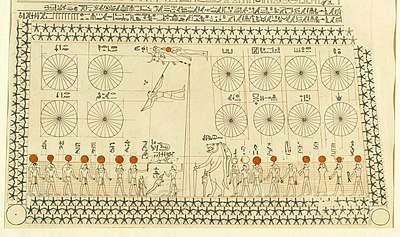
Astronomyis one of the oldestnatural sciences.Early civilizations dating before 3000 BCE, such as theSumerians,ancient Egyptians,and theIndus Valley Civilisation,had a predictive knowledge and a basic awareness of the motions of the Sun, Moon, and stars. The stars and planets, believed to represent gods, were often worshipped. While the explanations for the observed positions of the stars were often unscientific and lacking in evidence, these early observations laid the foundation for later astronomy, as the stars were found to traversegreat circlesacross the sky,[5]which could not explain the positions of theplanets.
According toAsger Aaboe,the origins of Western astronomy can be found inMesopotamia,and all Western efforts in theexact sciencesare descended from lateBabylonian astronomy.[10]Egyptian astronomersleft monuments showing knowledge of the constellations and the motions of the celestial bodies,[11]while Greek poetHomerwrote of various celestial objects in hisIliadandOdyssey;laterGreek astronomersprovided names, which are still used today, for most constellations visible from theNorthern Hemisphere.[12]
Natural philosophy
Natural philosophyhas its origins inGreeceduring theArchaic period(650 BCE – 480 BCE), whenpre-Socratic philosopherslikeThalesrejectednon-naturalisticexplanations for natural phenomena and proclaimed that every event had a natural cause.[13]They proposed ideas verified by reason and observation, and many of their hypotheses proved successful in experiment;[14]for example,atomismwas found to be correct approximately 2000 years after it was proposed byLeucippusand his pupilDemocritus.[15]
Aristotle and Hellenistic Physics
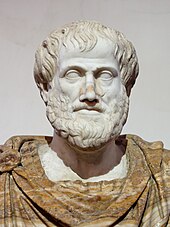
(384–322BCE)
During theclassical periodin Greece (6th, 5th and 4th centuries BCE) and inHellenistic times,natural philosophydeveloped along many lines of inquiry.Aristotle(Greek:Ἀριστοτέλης,Aristotélēs) (384–322 BCE), a student ofPlato, wrote on many subjects, including a substantial treatise on "Physics"– in the 4th century BC.Aristotelian physicswas influential for about two millennia. His approach mixed some limited observation with logical deductive arguments, but did not rely on experimental verification of deduced statements. Aristotle's foundational work in Physics, though very imperfect, formed a framework against which later thinkers further developed the field. His approach is entirely superseded today.
He explained ideas such asmotion(andgravity) with the theory offour elements. Aristotle believed that each of the fourclassical elements(air, fire, water, earth) had its own natural place.[16]Because of their differing densities, each element will revert to its own specific place in the atmosphere.[17]So, because of their weights, fire would be at the top, air underneath fire, then water, then lastly earth. He also stated that when a small amount of one element enters the natural place of another, the less abundant element will automatically go towards its own natural place. For example, if there is a fire on the ground, the flames go up into the air in an attempt to go back into its natural place where it belongs. His laws of motion included 1) heavier objects will fall faster, the speed being proportional to the weight and 2) the speed of the object that is falling depends inversely on the density object it is falling through (e.g. density of air).[18]He also stated that, when it comes to violent motion (motion of an object when a force is applied to it by a second object) that the speed that object moves, will only be as fast or strong as the measure of force applied to it.[18]The problem of motion and its causes was studied carefully, leading to the philosophical notion of a "primer mover"as the ultimate source of all motion in the world (Book 8 of his treatisePhysics).
Medieval European and Islamic
TheWestern Roman Empirefell to invaders and internal decay in the fifth century, resulting in a decline in intellectual pursuits in western Europe. By contrast, the Eastern Roman Empire (usually known as theByzantine Empire) resisted the attacks from invaders and continued to advance various fields of learning, including physics.[19]
In the sixth century,Isidore of Miletuscreated an important compilation ofArchimedes' works that are copied in theArchimedes Palimpsest.
In sixth-century EuropeJohn Philoponus,a Byzantine scholar, questionedAristotle's teaching of physics and noted its flaws. He introduced thetheory of impetus.Aristotle's physics was not scrutinized until Philoponus appeared; unlike Aristotle, who based his physics on verbal argument, Philoponus relied on observation. On Aristotle's physics Philoponus wrote:
But this is completely erroneous, and our view may be corroborated by actual observation more effectively than by any sort of verbal argument. For if you let fall from the same height two weights of which one is many times as heavy as the other, you will see that the ratio of the times required for the motion does not depend on the ratio of the weights, but that the difference in time is a very small one. And so, if the difference in the weights is not considerable, that is, of one is, let us say, double the other, there will be no difference, or else an imperceptible difference, in time, though the difference in weight is by no means negligible, with one body weighing twice as much as the other[20]
Philoponus' criticism of Aristotelian principles of physics served as an inspiration forGalileo Galileiten centuries later,[21]during theScientific Revolution.Galileo cited Philoponus substantially in his works when arguing that Aristotelian physics was flawed.[22][23]In the 1300sJean Buridan,a teacher in the faculty of arts at theUniversity of Paris,developed the concept of impetus. It was a step toward the modern ideas of inertia and momentum.[24]
Islamic scholarshipinheritedAristotelian physicsfrom the Greeks and during theIslamic Golden Agedeveloped it further, especially placing emphasis on observation anda priorireasoning, developing early forms of thescientific method.

The most notable innovations under Islamic scholarship were in the field ofopticsand vision,[26]which came from the works of many scientists likeIbn Sahl,Al-Kindi,Ibn al-Haytham,Al-FarisiandAvicenna.The most notable work wasThe Book of Optics(also known as Kitāb al-Manāẓir), written by Ibn al-Haytham, in which he presented the alternative to the ancient Greek idea about vision.[27]In hisTreatise on Lightas well as in hisKitāb al-Manāẓir,he presented a study of the phenomenon of thecamera obscura(his thousand-year-old version of thepinhole camera) and delved further into the way the eye itself works. Using the knowledge of previous scholars, he began to explain how light enters the eye. He asserted that the light ray is focused, but the actual explanation of how light projected to the back of the eye had to wait until 1604. HisTreatise on Lightexplained the camera obscura, hundreds of years before the modern development of photography.[28]
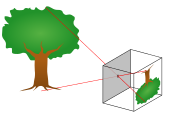
The seven-volumeBook of Optics(Kitab al-Manathir) influenced thinking[29]across disciplines from the theory of visualperceptionto the nature ofperspectivein medieval art, in both the East and the West, for more than 600 years. This included later European scholars and fellow polymaths, fromRobert GrossetesteandLeonardo da VincitoJohannes Kepler.
The translation ofThe Book of Opticshad an impact on Europe. From it, later European scholars were able to build devices that replicated those Ibn al-Haytham had built and understand the way vision works.

Classical
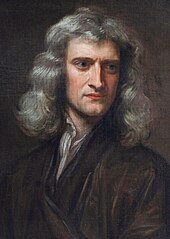
Physics became a separate science whenearly modern Europeansused experimental and quantitative methods to discover what are now considered to be thelaws of physics.[30][page needed]
Major developments in this period include the replacement of thegeocentric modelof theSolar Systemwith the heliocentricCopernican model,thelaws governing the motion of planetary bodies(determined by Kepler between 1609 and 1619), Galileo's pioneering work ontelescopesandobservational astronomyin the 16th and 17th centuries, andIsaac Newton's discovery and unification of thelaws of motionanduniversal gravitation(that would come to bear his name).[31]Newton also developedcalculus,[b]the mathematical study of continuous change, which provided new mathematical methods for solving physical problems.[32]
The discovery of laws inthermodynamics,chemistry,andelectromagneticsresulted from research efforts during theIndustrial Revolutionas energy needs increased.[33]The laws comprising classical physics remain widely used for objects on everyday scales travelling at non-relativistic speeds, since they provide a close approximation in such situations, and theories such asquantum mechanicsand thetheory of relativitysimplify to their classical equivalents at such scales. Inaccuracies inclassical mechanicsfor very small objects and very high velocities led to the development of modern physics in the 20th century.
Modern


Modern physicsbegan in the early 20th century with the work ofMax Planckin quantum theory andAlbert Einstein's theory of relativity. Both of these theories came about due to inaccuracies in classical mechanics in certain situations.Classical mechanicspredicted that thespeed of lightdepends on the motion of the observer, which could not be resolved with the constant speed predicted byMaxwell's equationsof electromagnetism. This discrepancy was corrected by Einstein's theory ofspecial relativity,which replaced classical mechanics for fast-moving bodies and allowed for a constant speed of light.[34]Black-body radiationprovided another problem for classical physics, which was corrected when Planck proposed that the excitation of material oscillators is possible only in discrete steps proportional to their frequency. This, along with thephotoelectric effectand a complete theory predicting discreteenergy levelsofelectron orbitals,led to the theory of quantum mechanics improving on classical physics at very small scales.[35]
Quantum mechanics would come to be pioneered byWerner Heisenberg,Erwin SchrödingerandPaul Dirac.[35]From this early work, and work in related fields, theStandard Model of particle physicswas derived.[36]Following the discovery of a particle with properties consistent with theHiggs bosonatCERNin 2012,[37]allfundamental particlespredicted by the standard model, and no others, appear to exist; however,physics beyond the Standard Model,with theories such assupersymmetry,is an active area of research.[38]Areas of mathematics in general are important to this field, such as the study ofprobabilitiesandgroups.
Philosophy
In many ways, physics stems fromancient Greek philosophy.FromThales' first attempt to characterize matter, toDemocritus' deduction that matter ought to reduce to an invariant state to thePtolemaic astronomyof a crystallinefirmament,and Aristotle's bookPhysics(an early book on physics, which attempted to analyze and define motion from a philosophical point of view), various Greek philosophers advanced their own theories of nature. Physics was known as natural philosophy until the late 18th century.[c]
By the 19th century, physics was realized as a discipline distinct from philosophy and the other sciences. Physics, as with the rest of science, relies on thephilosophy of scienceand its "scientific method"to advance knowledge of the physical world.[40]The scientific method employsa priori and a posteriorireasoning as well as the use ofBayesian inferenceto measure the validity of a given theory.[41]
The development of physics has answered many questions of early philosophers, but has also raised new questions. Study of the philosophical issues surrounding physics, thephilosophy of physics,involves issues such as the nature ofspace and time,determinism,andmetaphysicaloutlooks such asempiricism,naturalism,andrealism.[42]
Many physicists have written about the philosophical implications of their work, for instanceLaplace,who championedcausal determinism,[43]andErwin Schrödinger,who wrote on quantum mechanics.[44][45]The mathematical physicistRoger Penrosehas been called aPlatonistbyStephen Hawking,[46]a view Penrose discusses in his book,The Road to Reality.[47]Hawking referred to himself as an "unashamed reductionist" and took issue with Penrose's views.[48]
Core theories
Physics deals with a wide variety of systems, although certain theories are used by all physicists. Each of these theories was experimentally tested numerous times and found to be an adequate approximation of nature. For instance, the theory ofclassical mechanicsaccurately describes the motion of objects, provided they are much larger thanatomsand moving at a speed much less than the speed of light. These theories continue to be areas of active research today.Chaos theory,an aspect of classical mechanics, was discovered in the 20th century, three centuries after the original formulation of classical mechanics by Newton (1642–1727).
These central theories are important tools for research into more specialized topics, and any physicist, regardless of their specialization, is expected to be literate in them. These include classical mechanics, quantum mechanics, thermodynamics andstatistical mechanics,electromagnetism,and special relativity.
Classical
Classical physics includes the traditional branches and topics that were recognized and well-developed before the beginning of the 20th century—classical mechanics,acoustics,optics,thermodynamics, and electromagnetism. Classical mechanics is concerned with bodies acted on byforcesand bodies inmotionand may be divided intostatics(study of the forces on a body or bodies not subject to an acceleration),kinematics(study of motion without regard to its causes), anddynamics(study of motion and the forces that affect it); mechanics may also be divided intosolid mechanicsandfluid mechanics(known together ascontinuum mechanics), the latter include such branches ashydrostatics,hydrodynamicsandpneumatics.Acoustics is the study of how sound is produced, controlled, transmitted and received.[49]Important modern branches of acoustics includeultrasonics,the study of sound waves of very high frequency beyond the range of human hearing;bioacoustics,the physics of animal calls and hearing,[50]andelectroacoustics,the manipulation of audible sound waves using electronics.[51]
Optics, the study of light, is concerned not only withvisible lightbut also withinfraredandultraviolet radiation,which exhibit all of the phenomena of visible light except visibility, e.g., reflection, refraction, interference, diffraction, dispersion, and polarization of light. Heat is a form of energy, the internal energy possessed by the particles of which a substance is composed; thermodynamics deals with the relationships between heat and other forms of energy. Electricity andmagnetismhave been studied as a single branch of physics since the intimate connection between them was discovered in the early 19th century; anelectric currentgives rise to amagnetic field,and a changing magnetic field induces an electric current.Electrostaticsdeals withelectric chargesat rest,electrodynamicswith moving charges, andmagnetostaticswith magnetic poles at rest.
Modern
| Modern physics |
|---|
Classical physics is generally concerned with matter and energy on the normal scale of observation, while much of modern physics is concerned with the behavior of matter and energy under extreme conditions or on a very large or very small scale. For example,atomicandnuclear physicsstudy matter on the smallest scale at whichchemical elementscan be identified. Thephysics of elementary particlesis on an even smaller scale since it is concerned with the most basic units of matter; this branch of physics is also known as high-energy physics because of the extremely high energies necessary to produce many types of particles inparticle accelerators.On this scale, ordinary, commonsensical notions of space, time, matter, and energy are no longer valid.[52]
The two chief theories of modern physics present a different picture of the concepts of space, time, and matter from that presented by classical physics. Classical mechanics approximates nature as continuous, while quantum theory is concerned with the discrete nature of many phenomena at the atomic and subatomic level and with the complementary aspects of particles and waves in the description of such phenomena. The theory of relativity is concerned with the description of phenomena that take place in aframe of referencethat is in motion with respect to an observer; the special theory of relativity is concerned with motion in the absence of gravitational fields and thegeneral theory of relativitywith motion and its connection withgravitation.Both quantum theory and the theory of relativity find applications in many areas of modern physics.[53]
Fundamental concepts in modern physics
- Causality
- Covariance
- Action
- Physical field
- Symmetry
- Physical interaction
- Statistical ensemble
- Quantum
- Wave
- Particle
Difference
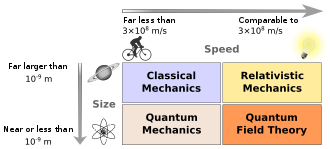
While physics itself aims to discover universal laws, its theories lie in explicit domains of applicability.
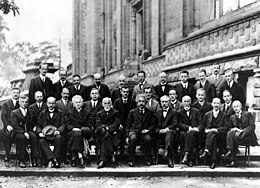
Loosely speaking, the laws of classical physics accurately describe systems whose important length scales are greater than the atomic scale and whose motions are much slower than the speed of light. Outside of this domain, observations do not match predictions provided by classical mechanics. Einstein contributed the framework of special relativity, which replaced notions ofabsolute time and spacewithspacetimeand allowed an accurate description of systems whose components have speeds approaching the speed of light. Planck, Schrödinger, and others introduced quantum mechanics, a probabilistic notion of particles and interactions that allowed an accurate description of atomic and subatomic scales. Later,quantum field theoryunified quantum mechanics and special relativity. General relativity allowed for a dynamical, curved spacetime, with which highly massive systems and the large-scale structure of the universe can be well-described. General relativity has not yet been unified with the other fundamental descriptions; several candidate theories ofquantum gravityare being developed.
Relation to other fields
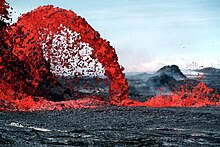

Prerequisites
Mathematics provides a compact and exact language used to describe the order in nature. This was noted and advocated byPythagoras,[54]Plato,[55]Galileo,[56]and Newton. Some theorists, likeHilary PutnamandPenelope Maddy,hold that logical truths, and therefore mathematical reasoning, depend on theempiricalworld. This is usually combined with the claim that the laws of logic express universal regularities found in the structural features of the world, which may explain the peculiar relation between these fields.
Physics uses mathematics[57]to organise and formulate experimental results. From those results,preciseorestimatedsolutions are obtained, or quantitative results, from which new predictions can be made and experimentally confirmed or negated. The results from physics experiments are numerical data, with theirunits of measureand estimates of the errors in the measurements. Technologies based on mathematics, likecomputationhave madecomputational physicsan active area of research.

Ontologyis a prerequisite for physics, but not for mathematics. It means physics is ultimately concerned with descriptions of the real world, while mathematics is concerned with abstract patterns, even beyond the real world. Thus physics statements are synthetic, while mathematical statements are analytic. Mathematics contains hypotheses, while physics contains theories. Mathematics statements have to be only logically true, while predictions of physics statements must match observed and experimental data.
The distinction is clear-cut, but not always obvious. For example,mathematical physicsis the application of mathematics in physics. Its methods are mathematical, but its subject is physical.[58]The problems in this field start with a "mathematical model of a physical situation"(system) and a" mathematical description of a physical law "that will be applied to that system. Every mathematical statement used for solving has a hard-to-find physical meaning. The final mathematical solution has an easier-to-find meaning, because it is what the solver is looking for.[clarification needed]
Pure physics is a branch offundamental science(also called basic science). Physics is also called "thefundamental science "because all branches of natural science like chemistry, astronomy, geology, and biology are constrained by laws of physics.[59]Similarly, chemistry is often calledthe central sciencebecause of its role in linking the physical sciences. For example, chemistry studies properties, structures, andreactionsof matter (chemistry's focus on the molecular and atomic scaledistinguishes it from physics). Structures are formed because particles exert electrical forces on each other, properties include physical characteristics of given substances, and reactions are bound by laws of physics, likeconservation of energy,mass,andcharge.Physics is applied in industries like engineering and medicine.
Application and influence


Applied physics is a general term for physics research, which is intended for a particular use. An applied physics curriculum usually contains a few classes in an applied discipline, like geology or electrical engineering. It usually differs from engineering in that an applied physicist may not be designing something in particular, but rather is using physics or conducting physics research with the aim of developing new technologies or solving a problem.
The approach is similar to that ofapplied mathematics.Applied physicists use physics in scientific research. For instance, people working onaccelerator physicsmight seek to build betterparticle detectorsfor research in theoretical physics.
Physics is used heavily in engineering. For example, statics, a subfield ofmechanics,is used in the building of bridges and other static structures. The understanding and use of acoustics results in sound control and better concert halls; similarly, the use of optics creates better optical devices. An understanding of physics makes for more realisticflight simulators,video games, and movies, and is often critical inforensicinvestigations.
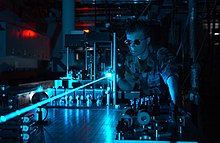
With thestandard consensusthat thelawsof physics are universal and do not change with time, physics can be used to study things that would ordinarily be mired inuncertainty.For example, in the study of the origin of the Earth, a physicist can reasonably model Earth's mass, temperature, and rate of rotation, as a function of time allowing the extrapolation forward or backward in time and so predict future or prior events. It also allows for simulations in engineering that speed up the development of a new technology.
There is also considerableinterdisciplinarity,so many other important fields are influenced by physics (e.g., the fields ofeconophysicsandsociophysics).
Research
Scientific method
Physicists use the scientific method to test the validity of aphysical theory.By using a methodical approach to compare the implications of a theory with the conclusions drawn from its related experiments and observations, physicists are better able to test the validity of a theory in a logical, unbiased, and repeatable way. To that end, experiments are performed and observations are made in order to determine the validity or invalidity of a theory.[60]
A scientific law is a concise verbal or mathematical statement of a relation that expresses a fundamental principle of some theory, such as Newton's law of universal gravitation.[61]
Theory and experiment
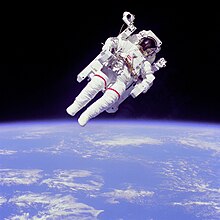
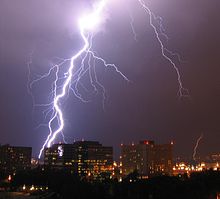
Theorists seek to developmathematical modelsthat both agree with existing experiments and successfully predict future experimental results, whileexperimentalistsdevise and perform experiments to test theoretical predictions and explore new phenomena. Althoughtheoryand experiment are developed separately, they strongly affect and depend upon each other. Progress in physics frequently comes about when experimental results defy explanation by existing theories, prompting intense focus on applicable modelling, and when new theories generate experimentally testablepredictions,which inspire the development of new experiments (and often related equipment).[62]
Physicistswho work at the interplay of theory and experiment are calledphenomenologists,who study complex phenomena observed in experiment and work to relate them to afundamental theory.[63]
Theoretical physics has historically taken inspiration from philosophy; electromagnetism was unified this way.[d]Beyond the known universe, the field of theoretical physics also deals with hypothetical issues,[e]such asparallel universes,amultiverse,andhigher dimensions.Theorists invoke these ideas in hopes of solving particular problems with existing theories; they then explore the consequences of these ideas and work toward making testable predictions.
Experimental physics expands, and is expanded by, engineering and technology. Experimental physicists who are involved inbasic researchdesign and perform experiments with equipment such as particle accelerators andlasers,whereas those involved inapplied researchoften work in industry, developing technologies such asmagnetic resonance imaging(MRI) andtransistors.Feynmanhas noted that experimentalists may seek areas that have not been explored well by theorists.[64]
Scope and aims

Physics covers a wide range ofphenomena,fromelementary particles(such asquarks,neutrinos,andelectrons) to the largestsuperclustersof galaxies. Included in these phenomena are the most basic objects composing all other things. Therefore, physics is sometimes called the "fundamental science".[59]Physics aims to describe the various phenomena that occur in nature in terms of simpler phenomena. Thus, physics aims to both connect the things observable to humans to root causes, and then connect these causes together.
For example, theancient Chineseobserved that certain rocks (lodestoneandmagnetite) were attracted to one another by an invisible force. This effect was later called magnetism, which was first rigorously studied in the 17th century. But even before the Chinese discovered magnetism, theancient Greeksknew of other objects such asamber,that when rubbed with fur would cause a similar invisible attraction between the two.[65]This was also first studied rigorously in the 17th century and came to be called electricity. Thus, physics had come to understand two observations of nature in terms of some root cause (electricity and magnetism). However, further work in the 19th century revealed that these two forces were just two different aspects of one force—electromagnetism.This process of "unifying" forces continues today, and electromagnetism and theweak nuclear forceare now considered to be two aspects of theelectroweak interaction.Physics hopes to find an ultimate reason (theory of everything) for why nature is as it is (see sectionCurrent researchbelow for more information).[66]
Research fields
Contemporary research in physics can be broadly divided intonuclearandparticle physics;condensed matter physics;atomic, molecular, and optical physics;astrophysics;and applied physics. Some physics departments also supportphysics education researchandphysics outreach.[67]
Since the 20th century, the individual fields of physics have become increasingly specialised, and today most physicists work in a single field for their entire careers. "Universalists" such as Einstein (1879–1955) andLev Landau(1908–1968), who worked in multiple fields of physics, are now very rare.[f]
The major fields of physics, along with their subfields and the theories and concepts they employ, are shown in the following table.
Nuclear and particle

Particle physics is the study of the elementary constituents ofmatterand energy and theinteractionsbetween them.[68]In addition, particle physicists design and develop the high-energy accelerators,[69]detectors,[70]andcomputer programs[71]necessary for this research. The field is also called "high-energy physics" because many elementary particles do not occur naturally but are created only during high-energycollisionsof other particles.[72]
Currently, the interactions of elementary particles andfieldsare described by theStandard Model.[73]The model accounts for the 12 known particles of matter (quarksandleptons) that interact via thestrong,weak, and electromagneticfundamental forces.[73]Dynamics are described in terms of matter particles exchanginggauge bosons(gluons,W and Z bosons,andphotons,respectively).[74]The Standard Model also predicts a particle known as the Higgs boson.[73]In July 2012 CERN, the European laboratory for particle physics, announced the detection of a particle consistent with the Higgs boson,[75]an integral part of theHiggs mechanism.
Nuclear physics is the field of physics that studies the constituents and interactions ofatomic nuclei.The most commonly known applications of nuclear physics arenuclear powergeneration andnuclear weaponstechnology, but the research has provided application in many fields, including those innuclear medicineand magnetic resonance imaging,ion implantationinmaterials engineering,andradiocarbon datingin geology andarchaeology.
Atomic, molecular, and optical
Atomic,molecular,and optical physics (AMO) is the study of matter—matter and light—matter interactions on the scale of single atoms and molecules. The three areas are grouped together because of their interrelationships, the similarity of methods used, and the commonality of their relevant energy scales. All three areas include both classical, semi-classical andquantumtreatments; they can treat their subject from a microscopic view (in contrast to a macroscopic view).
Atomic physics studies theelectron shellsof atoms. Current research focuses on activities in quantum control, cooling and trapping of atoms and ions,[76][77][78]low-temperature collision dynamics and the effects of electron correlation on structure and dynamics. Atomic physics is influenced by thenucleus(seehyperfine splitting), but intra-nuclear phenomena such asfissionandfusionare considered part of nuclear physics.
Molecular physicsfocuses on multi-atomic structures and their internal and external interactions with matter and light.Optical physicsis distinct from optics in that it tends to focus not on the control of classical light fields by macroscopic objects but on the fundamental properties ofoptical fieldsand their interactions with matter in the microscopic realm.
Condensed matter

Condensed matter physics is the field of physics that deals with the macroscopic physical properties of matter.[79][80]In particular, it is concerned with the "condensed"phasesthat appear whenever the number of particles in a system is extremely large and the interactions between them are strong.[81]
The most familiar examples of condensed phases aresolidsand liquids, which arise from the bonding by way of theelectromagnetic forcebetween atoms.[82]More exotic condensed phases include thesuperfluid[83]and theBose–Einstein condensate[84]found in certain atomic systems at very low temperature, thesuperconductingphase exhibited byconduction electronsin certain materials,[85]and theferromagneticandantiferromagneticphases ofspinsonatomic lattices.[86]
Condensed matter physics is the largest field of contemporary physics. Historically, condensed matter physics grew out of solid-state physics, which is now considered one of its main subfields.[87]The termcondensed matter physicswas apparently coined byPhilip Andersonwhen he renamed his research group—previouslysolid-state theory—in 1967.[88]In 1978, the Division of Solid State Physics of theAmerican Physical Societywas renamed as the Division of Condensed Matter Physics.[87]Condensed matter physics has a large overlap with chemistry,materials science,nanotechnologyand engineering.[81]
Astrophysics

Astrophysics and astronomy are the application of the theories and methods of physics to the study ofstellar structure,stellar evolution,the origin of the Solar System, and related problems of cosmology. Because astrophysics is a broad subject, astrophysicists typically apply many disciplines of physics, including mechanics, electromagnetism, statistical mechanics, thermodynamics, quantum mechanics, relativity, nuclear and particle physics, and atomic and molecular physics.[89]
The discovery byKarl Janskyin 1931 that radio signals were emitted by celestial bodies initiated the science ofradio astronomy.Most recently, the frontiers of astronomy have been expanded by space exploration. Perturbations and interference from the Earth's atmosphere make space-based observations necessary forinfrared,ultraviolet,gamma-ray,andX-ray astronomy.
Physical cosmology is the study of the formation and evolution of the universe on its largest scales. Albert Einstein's theory of relativity plays a central role in all modern cosmological theories. In the early 20th century,Hubble's discovery that the universe is expanding, as shown by theHubble diagram,prompted rival explanations known as thesteady stateuniverse and theBig Bang.
The Big Bang was confirmed by the success ofBig Bang nucleosynthesisand the discovery of thecosmic microwave backgroundin 1964. The Big Bang model rests on two theoretical pillars: Albert Einstein's general relativity and thecosmological principle.Cosmologists have recently established theΛCDM modelof the evolution of the universe, which includescosmic inflation,dark energy,anddark matter.
Numerous possibilities and discoveries are anticipated to emerge from new data from theFermi Gamma-ray Space Telescopeover the upcoming decade and vastly revise or clarify existing models of the universe.[90][91]In particular, the potential for a tremendous discovery surrounding dark matter is possible over the next several years.[92]Fermi will search for evidence that dark matter is composed ofweakly interacting massive particles,complementing similar experiments with theLarge Hadron Colliderand other underground detectors.
IBEXis already yielding newastrophysicaldiscoveries: "No one knows what is creating theENA (energetic neutral atoms)ribbon "along thetermination shockof thesolar wind,"but everyone agrees that it means the textbook picture of theheliosphere—in which the Solar System's enveloping pocket filled with the solar wind's charged particles is plowing through the onrushing 'galactic wind' of the interstellar medium in the shape of a comet—is wrong. "[93]
Current research
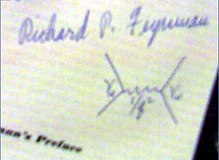

Research in physics is continually progressing on a large number of fronts.
In condensed matter physics, an important unsolved theoretical problem is that ofhigh-temperature superconductivity.[94]Many condensed matter experiments are aiming to fabricate workablespintronicsandquantum computers.[81][95]
In particle physics, the first pieces of experimental evidence for physics beyond the Standard Model have begun to appear. Foremost among these are indications thatneutrinoshave non-zeromass.These experimental results appear to have solved the long-standingsolar neutrino problem,and the physics of massive neutrinos remains an area of active theoretical and experimental research. The Large Hadron Collider has already found the Higgs boson, but future research aims to prove or disprove thesupersymmetry,which extends the Standard Model of particle physics. Research on the nature of the major mysteries of dark matter anddark energyis also currently ongoing.[96]
Although much progress has been made in high-energy,quantum,and astronomical physics, many everyday phenomena involvingcomplexity,[97]chaos,[98]orturbulence[99]are still poorly understood. Complex problems that seem like they could be solved by a clever application of dynamics and mechanics remain unsolved; examples include the formation of sandpiles, nodes in trickling water, the shape of water droplets, mechanisms ofsurface tensioncatastrophes,and self-sorting in shaken heterogeneous collections.[g][100]
These complex phenomena have received growing attention since the 1970s for several reasons, including the availability of modern mathematical methods and computers, which enabledcomplex systemsto be modeled in new ways. Complex physics has become part of increasingly interdisciplinary research, as exemplified by the study of turbulence in aerodynamics and the observation ofpattern formationin biological systems. In the 1932Annual Review of Fluid Mechanics,Horace Lambsaid:[101]
I am an old man now, and when I die and go to heaven there are two matters on which I hope for enlightenment. One is quantum electrodynamics, and the other is the turbulent motion of fluids. And about the former I am rather optimistic.
Education
Career
Aphysicistis ascientistwho specializes in the field of physics, which encompasses the interactions of matter and energy at all length and time scales in the physical universe.[102][103]Physicists generally are interested in the root or ultimate causes ofphenomena,and usually frame their understanding in mathematical terms. They work across a wide range ofresearch fields,spanning all length scales: fromsub-atomicandparticle physics,throughbiological physics,tocosmologicallength scales encompassing theuniverseas a whole. The field generally includes two types of physicists:experimental physicistswho specialize in the observation of natural phenomena and the development and analysis of experiments, andtheoretical physicistswho specialize in mathematical modeling of physical systems to rationalize, explain and predict natural phenomena.[102]
Physicists can apply their knowledge towards solving practical problems or to developing new technologies (also known asapplied physicsorengineering physics).[104][105][106]See also
- Earth science– Fields of natural science related to Earth
- Neurophysics– branch of biophysics dealing with the development and use of physical methods to gain information about the nervous system
- Psychophysics– Branch of knowledge relating physical stimuli and psychological perception
- Relationship between mathematics and physics
- Science tourism– Travel to notable science locations
Lists
Notes
- ^Francis Bacon's 1620Novum Organumwas critical in thedevelopment of scientific method.[6]
- ^Calculus was independently developed at around the same time byGottfried Wilhelm Leibniz;while Leibniz was the first to publish his work and develop much of the notation used for calculus today, Newton was the first to develop calculus and apply it to physical problems. See alsoLeibniz–Newton calculus controversy
- ^Noll notes that some universities still use this title.[39]
- ^See, for example, the influence ofKantandRitteronØrsted.
- ^Concepts which are denotedhypotheticalcan change with time. For example, theatomof nineteenth-century physics was denigrated by some, includingErnst Mach's critique ofLudwig Boltzmann's formulation ofstatistical mechanics.By the end of World War II, the atom was no longer deemed hypothetical.
- ^Yet, universalism is encouraged in the culture of physics. For example, theWorld Wide Web,which was innovated atCERNbyTim Berners-Lee,was created in service to the computer infrastructure of CERN, and was/is intended for use by physicists worldwide. The same might be said forarXiv.org
- ^See the work ofIlya Prigogine,on 'systems far from equilibrium', and others.
References
- ^Maxwell 1878,p. 9 "Physical science is that department of knowledge which relates to the order of nature, or, in other words, to the regular succession of events."
- ^abcYoung & Freedman 2014,p. 1 "Physics is one of the most fundamental of the sciences. Scientists of all disciplines use the ideas of physics, including chemists who study the structure of molecules, paleontologists who try to reconstruct how dinosaurs walked, and climatologists who study how human activities affect the atmosphere and oceans. Physics is also the foundation of all engineering and technology. No engineer could design a flat-screen TV, an interplanetary spacecraft, or even a better mousetrap without first understanding the basic laws of physics. (...) You will come to see physics as a towering achievement of the human intellect in its quest to understand our world and ourselves."
- ^Young & Freedman 2014,p. 2 "Physics is an experimental science. Physicists observe the phenomena of nature and try to find patterns that relate these phenomena."
- ^Holzner 2006,p. 7 "Physics is the study of your world and the world and universe around you."
- ^abKrupp 2003
- ^Cajori 1917,pp. 48–49
- ^"physics".Online Etymology Dictionary.Archivedfrom the original on 24 December 2016.Retrieved1 November2016.
- ^"physic".Online Etymology Dictionary.Archivedfrom the original on 24 December 2016.Retrieved1 November2016.
- ^φύσις,φυσική,ἐπιστήμη.Liddell, Henry George;Scott, Robert;A Greek–English Lexiconat thePerseus Project
- ^Aaboe 1991
- ^Clagett 1995
- ^Thurston 1994
- ^Singer 2008,p. 35
- ^Lloyd 1970,pp. 108–109
- ^ Gill, N. S."Atomism – Pre-Socratic Philosophy of Atomism".About Education.Archivedfrom the original on 10 July 2014.Retrieved1 April2014.
- ^"Daily 40 no. 2 – Aristotle and the Four Simple Bodies and Elements"(PDF).Cal State LA.Archived fromthe original(PDF)on 6 January 2023.Retrieved27 September2023.
- ^tbcaldwe (14 October 2012)."Natural Philosophy: Aristotle | Physics 139".Retrieved17 December2022.
- ^ab"Aristotle".galileoandeinstein.phys.virginia.edu.Retrieved17 December2022.
- ^Lindberg 1992,p. 363.
- ^"John Philoponus, Commentary on Aristotle's Physics".Archived fromthe originalon 11 January 2016.Retrieved15 April2018.
- ^Galileo(1638).Two New Sciences.
in order to better understand just how conclusive Aristotle's demonstration is, we may, in my opinion, deny both of his assumptions. And as to the first, I greatly doubt that Aristotle ever tested by experiment whether it be true that two stones, one weighing ten times as much as the other, if allowed to fall, at the same instant, from a height of, say, 100 cubits, would so differ in speed that when the heavier had reached the ground, the other would not have fallen more than 10 cubits.
Simp. – His language would seem to indicate that he had tried the experiment, because he says: We see the heavier; now the word see shows that he had made the experiment.
Sagr. – But I, Simplicio, who have made the test can assure[107] you that a cannon ball weighing one or two hundred pounds, or even more, will not reach the ground by as much as a span ahead of a musket ball weighing only half a pound, provided both are dropped from a height of 200 cubits. - ^Lindberg 1992,p. 162.
- ^"John Philoponus".The Stanford Encyclopedia of Philosophy.Metaphysics Research Lab, Stanford University. 2018.Archivedfrom the original on 22 April 2018.Retrieved11 April2018.
- ^"John Buridan".The Stanford Encyclopedia of Philosophy.Metaphysics Research Lab, Stanford University. 2018.Archivedfrom the original on 22 April 2018.Retrieved11 April2018.
- ^Smith 2001,Book I [6.85], [6.86], p. 379; Book II, [3.80], p. 453.
- ^Dallal, Ahmad (2010).Islam, Science, and the Challenge of History.New Haven: Yale University Press. p. 38.
Within two centuries, the field of optics was radically transformed
- ^Tbakhi, Abdelghani; Amr, Samir S. (2007)."Ibn Al-Haytham: Father of Modern Optics".Annals of Saudi Medicine.27(6): 464–467.doi:10.5144/0256-4947.2007.464.ISSN0256-4947.PMC6074172.PMID18059131.
- ^Howard & Rogers 1995,pp. 6–7
- ^Al-Khalili, Jim (February 2015)."In retrospect: Book of Optics".Nature.518(7538): 164–165.Bibcode:2015Natur.518..164A.doi:10.1038/518164a.ISSN1476-4687.
- ^Ben-Chaim 2004
- ^Guicciardini 1999
- ^Allen 1997
- ^"The Industrial Revolution".Schoolscience.org,Institute of Physics.Archivedfrom the original on 7 April 2014.Retrieved1 April2014.
- ^O'Connor & Robertson 1996a
- ^abO'Connor & Robertson 1996b
- ^"The Standard Model".DONUT.Fermilab.29 June 2001.Archivedfrom the original on 31 May 2014.Retrieved1 April2014.
- ^Cho 2012
- ^Womersley, J. (February 2005)."Beyond the Standard Model"(PDF).Symmetry.Vol. 2, no. 1. pp. 22–25.Archived(PDF)from the original on 24 September 2015.
- ^Noll, Walter (23 June 2006)."On the Past and Future of Natural Philosophy"(PDF).Journal of Elasticity.84(1): 1–11.doi:10.1007/s10659-006-9068-y.ISSN0374-3535.S2CID121957320.Archived(PDF)from the original on 18 April 2016.
- ^Rosenberg 2006,Chapter 1
- ^Godfrey-Smith 2003,Chapter 14: "Bayesianism and Modern Theories of Evidence"
- ^Godfrey-Smith 2003,Chapter 15: "Empiricism, Naturalism, and Scientific Realism?"
- ^Laplace 1951
- ^Schrödinger 1983
- ^Schrödinger 1995
- ^Hawking & Penrose 1996,p. 4. "I think that Roger is a Platonist at heart but he must answer for himself."
- ^Penrose 2004
- ^Penrose et al. 1997
- ^"acoustics".Encyclopædia Britannica.Archivedfrom the original on 18 June 2013.Retrieved14 June2013.
- ^"Bioacoustics – the International Journal of Animal Sound and its Recording".Taylor & Francis.Archivedfrom the original on 5 September 2012.Retrieved31 July2012.
- ^"Acoustics and You (A Career in Acoustics?)".Acoustical Society of America.Archived fromthe originalon 4 September 2015.Retrieved21 May2013.
- ^Tipler & Llewellyn 2003,pp. 269, 477, 561
- ^Tipler & Llewellyn 2003,pp. 1–4, 115, 185–187
- ^Dijksterhuis 1986
- ^Mastin 2010"Although usually remembered today as a philosopher, Plato was also one of ancient Greece's most important patrons of mathematics. Inspired by Pythagoras, he founded his Academy in Athens in 387 BC, where he stressed mathematics as a way of understanding more about reality. In particular, he was convinced that geometry was the key to unlocking the secrets of the universe. The sign above the Academy entrance read: 'Let no-one ignorant of geometry enter here.'"
- ^Toraldo Di Francia 1976,p. 10 'Philosophy is written in that great book which ever lies before our eyes. I mean the universe, but we cannot understand it if we do not first learn the language and grasp the symbols in which it is written. This book is written in the mathematical language, and the symbols are triangles, circles, and other geometrical figures, without whose help it is humanly impossible to comprehend a single word of it, and without which one wanders in vain through a dark labyrinth.' – Galileo (1623),The Assayer"
- ^"Applications of Mathematics to the Sciences".25 January 2000. Archived fromthe originalon 10 May 2015.Retrieved30 January2012.
- ^"Journal of Mathematical Physics".Archivedfrom the original on 18 August 2014.Retrieved31 March2014.
[Journal of Mathematical Physics] purpose is the publication of papers in mathematical physics—that is, the application of mathematics to problems in physics and the development of mathematical methods suitable for such applications and for the formulation of physical theories.
- ^abThe Feynman Lectures on Physics Vol. I Ch. 3: The Relation of Physics to Other Sciences;see alsoreductionismandspecial sciences
- ^Ellis, G.; Silk, J. (16 December 2014)."Scientific method: Defend the integrity of physics".Nature.516(7531): 321–323.Bibcode:2014Natur.516..321E.doi:10.1038/516321a.PMID25519115.
- ^Honderich 1995,pp. 474–476
- ^"Has theoretical physics moved too far away from experiments? Is the field entering a crisis and, if so, what should we do about it?".Perimeter Institute for Theoretical Physics.June 2015. Archived fromthe originalon 21 April 2016.
- ^"Phenomenology".Max Planck Institute for Physics.Archived fromthe originalon 7 March 2016.Retrieved22 October2016.
- ^Feynman 1965,p. 157 "In fact experimenters have a certain individual character. They... very often do their experiments in a region in which people know the theorist has not made any guesses."
- ^Stewart, J. (2001).Intermediate Electromagnetic Theory.World Scientific. p. 50.ISBN978-981-02-4471-2.
- ^Weinberg, S. (1993).Dreams of a Final Theory: The Search for the Fundamental Laws of Nature.Hutchinson Radius.ISBN978-0-09-177395-3.
- ^Redish, E."Science and Physics Education Homepages".University of Maryland Physics Education Research Group.Archivedfrom the original on 28 July 2016.
- ^"Division of Particles & Fields".American Physical Society. Archived fromthe originalon 29 August 2016.Retrieved18 October2012.
- ^Halpern 2010
- ^Grupen 1999
- ^Walsh 2012
- ^"High Energy Particle Physics Group".Institute of Physics.Archivedfrom the original on 29 May 2019.Retrieved18 October2012.
- ^abcOerter 2006
- ^Gribbin, Gribbin & Gribbin 1998
- ^"CERN experiments observe particle consistent with long-sought Higgs boson".CERN.4 July 2012. Archived fromthe originalon 14 November 2012.Retrieved18 October2012.
- ^"Atomic, Molecular, and Optical Physics".MIT Department of Physics.Archivedfrom the original on 27 February 2014.Retrieved21 February2014.
- ^"Korea University, Physics AMO Group".Archived fromthe originalon 1 March 2014.Retrieved21 February2014.
- ^"Aarhus Universitet, AMO Group".Archivedfrom the original on 7 March 2014.Retrieved21 February2014.
- ^Taylor & Heinonen 2002
- ^Girvin, Steven M.; Yang, Kun (28 February 2019).Modern Condensed Matter Physics.Cambridge University Press.ISBN978-1-108-57347-4.Archivedfrom the original on 25 February 2021.Retrieved23 August2020.
- ^abcCohen 2008
- ^Moore 2011,pp. 255–258
- ^Leggett 1999
- ^Levy 2001
- ^Stajic, Coontz & Osborne 2011
- ^Mattis 2006
- ^ab"History of Condensed Matter Physics".American Physical Society.Archivedfrom the original on 12 September 2011.Retrieved31 March2014.
- ^"Philip Anderson".Princeton University, Department of Physics.Archivedfrom the original on 8 October 2011.Retrieved15 October2012.
- ^"BS in Astrophysics".University of Hawaii at Manoa. Archived fromthe originalon 4 April 2016.Retrieved14 October2016.
- ^"NASA – Q&A on the GLAST Mission".Nasa: Fermi Gamma-ray Space Telescope.NASA.28 August 2008.Archivedfrom the original on 25 April 2009.Retrieved29 April2009.
- ^See alsoNasa – Fermi ScienceArchived3 April 2010 at theWayback MachineandNASA – Scientists Predict Major Discoveries for GLASTArchived2 March 2009 at theWayback Machine.
- ^"Dark Matter".NASA.28 August 2008.Archivedfrom the original on 13 January 2012.Retrieved30 January2012.
- ^Kerr 2009
- ^Leggett, A. J. (2006)."What DO we know about highTc?"(PDF).Nature Physics.2(3): 134–136.Bibcode:2006NatPh...2..134L.doi:10.1038/nphys254.S2CID122055331.Archived fromthe original(PDF)on 10 June 2010.
- ^Wolf, S. A.; Chtchelkanova, A. Y.; Treger, D. M. (2006)."Spintronics – A retrospective and perspective"(PDF).IBM Journal of Research and Development.50:101–110.doi:10.1147/rd.501.0101.S2CID41178069.Archived fromthe original(PDF)on 24 September 2020.
- ^Gibney, E. (2015)."LHC 2.0: A new view of the Universe".Nature.519(7542): 142–143.Bibcode:2015Natur.519..142G.doi:10.1038/519142a.PMID25762263.
- ^National Research Council & Committee on Technology for Future Naval Forces 1997,p. 161
- ^Kellert 1993,p. 32
- ^Eames, I.; Flor, J. B. (2011)."New developments in understanding interfacial processes in turbulent flows".Philosophical Transactions of the Royal Society A.369(1937): 702–705.Bibcode:2011RSPTA.369..702E.doi:10.1098/rsta.2010.0332.PMID21242127.
Richard Feynman said that 'Turbulence is the most important unsolved problem of classical physics'
- ^National Research Council (2007)."What happens far from equilibrium and why".Condensed-Matter and Materials Physics: the science of the world around us.pp. 91–110.doi:10.17226/11967.ISBN978-0-309-10969-7.Archivedfrom the original on 4 November 2016.
–Jaeger, Heinrich M.;Liu, Andrea J.(2010). "Far-From-Equilibrium Physics: An Overview".arXiv:1009.4874[cond-mat.soft]. - ^Goldstein 1969
- ^abRosen, Joe (2009).Encyclopedia of Physics.Infobase Publishing. p. 247.
- ^"physicist".Merriam-Webster.com Dictionary.Merriam-Webster."a scientist who studies or is a specialist in physics"
- ^"Industrial Physicists: Primarily specializing in Physics"(PDF).American Institute for Physics. October 2016.
- ^"Industrial Physicists: Primarily specializing in Engineering"(PDF).American Institute for Physics. October 2016.
- ^"Industrial Physicists: Primarily specializing outside of STEM sectors"(PDF).American Institute for Physics. October 2016.
Sources
- Aaboe, A.(1991). "Mesopotamian Mathematics, Astronomy, and Astrology".The Cambridge Ancient History.Vol. III (2nd ed.). Cambridge University Press.ISBN978-0-521-22717-9.
- Allen, D. (10 April 1997)."Calculus".Texas A&M University. Archived fromthe originalon 23 March 2021.Retrieved1 April2014.
- Ben-Chaim, M. (2004).Experimental Philosophy and the Birth of Empirical Science: Boyle, Locke and Newton.Aldershot: Ashgate Publishing.ISBN978-0-7546-4091-2.OCLC53887772.
- Cajori, Florian (1917).A History of Physics in Its Elementary Branches: Including the Evolution of Physical Laboratories.Macmillan.
- Cho, A. (13 July 2012). "Higgs Boson Makes Its Debut After Decades-Long Search".Science.337(6091): 141–143.Bibcode:2012Sci...337..141C.doi:10.1126/science.337.6091.141.PMID22798574.
- Clagett, M. (1995).Ancient Egyptian Science.Vol. 2. Philadelphia: American Philosophical Society.
- Cohen, M.L. (2008)."Fifty Years of Condensed Matter Physics".Physical Review Letters.101(5): 25001–25006.Bibcode:2008PhRvL.101y0001C.doi:10.1103/PhysRevLett.101.250001.PMID19113681.
- Dijksterhuis, E.J. (1986).The mechanization of the world picture: Pythagoras to Newton.Princeton, New Jersey: Princeton University Press.ISBN978-0-691-08403-9.Archived fromthe originalon 5 August 2011.
- Feynman, R.P.;Leighton, R.B.; Sands, M. (1963).The Feynman Lectures on Physics.Vol. 1.ISBN978-0-201-02116-5.
- Feynman, R.P.(1965).The Character of Physical Law.M.I.T. Press.ISBN978-0-262-56003-0.
- Godfrey-Smith, P. (2003).Theory and Reality: An Introduction to the Philosophy of Science.ISBN978-0-226-30063-4.
- Goldstein, S. (1969). "Fluid Mechanics in the First Half of this Century".Annual Review of Fluid Mechanics.1(1): 1–28.Bibcode:1969AnRFM...1....1G.doi:10.1146/annurev.fl.01.010169.000245.
- Gribbin, J.R.; Gribbin, M.; Gribbin, J. (1998).Q is for Quantum: An Encyclopedia of Particle Physics.Free Press.Bibcode:1999qqep.book.....G.ISBN978-0-684-85578-3.
- Grupen, Klaus (10 July 1999). "Instrumentation in Elementary Particle Physics: VIII ICFA School".AIP Conference Proceedings.536:3–34.arXiv:physics/9906063.Bibcode:2000AIPC..536....3G.doi:10.1063/1.1361756.S2CID119476972.
- Guicciardini, N. (1999).Reading the Principia: The Debate on Newton's Methods for Natural Philosophy from 1687 to 1736.New York: Cambridge University Press.ISBN978-0521640664.
- Halpern, P. (2010).Collider: The Search for the World's Smallest Particles.John Wiley & Sons.ISBN978-0-470-64391-4.
- Hawking, S.;Penrose, R.(1996).The Nature of Space and Time.Princeton University Press.ISBN978-0-691-05084-3.
- Holzner, S. (2006).Physics for Dummies.John Wiley & Sons.Bibcode:2005pfd..book.....H.ISBN978-0-470-61841-7.
Physics is the study of your world and the world and universe around you.
- Honderich, T., ed. (1995).The Oxford Companion to Philosophy(1 ed.). Oxford: Oxford University Press. pp.474–476.ISBN978-0-19-866132-0.
- Howard, Ian; Rogers, Brian (1995).Binocular Vision and Stereopsis.Oxford University Press.ISBN978-0-19-508476-4.
- Kellert, S.H. (1993).In the Wake of Chaos: Unpredictable Order in Dynamical Systems.University of Chicago Press.ISBN978-0-226-42976-2.
- Kerr, R.A. (16 October 2009)."Tying Up the Solar System With a Ribbon of Charged Particles".Science.326(5951): 350–351.doi:10.1126/science.326_350a.PMID19833930.
- Krupp, E.C. (2003).Echoes of the Ancient Skies: The Astronomy of Lost Civilizations.Dover Publications.ISBN978-0-486-42882-6.Retrieved31 March2014.
- Laplace, P.S.(1951).A Philosophical Essay on Probabilities.Translated from the 6th French edition by Truscott, F.W. and Emory, F.L. New York: Dover Publications.
- Leggett, A.J. (1999). "Superfluidity".Reviews of Modern Physics.71(2): S318–S323.Bibcode:1999RvMPS..71..318L.doi:10.1103/RevModPhys.71.S318.
- Levy, Barbara G.(December 2001)."Cornell, Ketterle, and Wieman Share Nobel Prize for Bose-Einstein Condensates".Physics Today.54(12): 14.Bibcode:2001PhT....54l..14L.doi:10.1063/1.1445529.
- Lindberg, David (1992).The Beginnings of Western Science.University of Chicago Press.
- Lloyd, G.E.R.(1970).Early Greek Science: Thales to Aristotle.London; New York: Chatto and Windus; W. W. Norton & Company.ISBN978-0-393-00583-7.
- Mastin, Luke (2010)."Plato".lukemastin.com.
- Mattis, D.C. (2006).The Theory of Magnetism Made Simple.World Scientific.ISBN978-981-238-579-6.
- Maxwell, J.C.(1878).Matter and Motion.D. Van Nostrand.ISBN978-0-486-66895-6.
matter and motion.
- Moore, J.T. (2011).Chemistry For Dummies(2 ed.). John Wiley & Sons.ISBN978-1-118-00730-3.
- National Research Council;Committee on Technology for Future Naval Forces (1997).Technology for the United States Navy and Marine Corps, 2000–2035 Becoming a 21st-Century Force: Volume 9: Modeling and Simulation.Washington, DC: The National Academies Press.ISBN978-0-309-05928-2.
- O'Connor, J.J.;Robertson, E.F.(February 1996a)."Special Relativity".MacTutor History of Mathematics archive.University of St Andrews.Retrieved1 April2014.
- O'Connor, J.J.;Robertson, E.F.(May 1996b)."A History of Quantum Mechanics".MacTutor History of Mathematics archive.University of St Andrews.Retrieved1 April2014.
- Oerter, R. (2006).The Theory of Almost Everything: The Standard Model, the Unsung Triumph of Modern Physics.Pi Press.ISBN978-0-13-236678-6.
- Penrose, R.;Shimony, A.; Cartwright, N.;Hawking, S.(1997).The Large, the Small and the Human Mind.Cambridge University Press.ISBN978-0-521-78572-3.
- Penrose, R.(2004).The Road to Reality.A.A. Knopf.ISBN978-0-679-45443-4.
- Rosenberg, Alex (2006).Philosophy of Science.Routledge.ISBN978-0-415-34317-6.
- Schrödinger, E. (1983).My View of the World.Ox Bow Press.ISBN978-0-918024-30-5.
- Schrödinger, E. (1995).The Interpretation of Quantum Mechanics.Ox Bow Press.ISBN978-1-881987-09-3.
- Singer, C. (2008).A Short History of Science to the 19th Century.Streeter Press.
- Smith, A. Mark (2001).Alhacen's Theory of Visual Perception: A Critical Edition, with English Translation and Commentary, of the First Three Books of Alhacen'sDe Aspectibus,the Medieval Latin Version of Ibn al-Haytham'sKitāb al-Manāẓir,2 vols.Transactions of the American Philosophical Society. Vol. 91.Philadelphia:American Philosophical Society.ISBN978-0-87169-914-5.OCLC47168716.
- Smith, A. Mark (2001a). "Alhacen's Theory of Visual Perception: A Critical Edition, with English Translation and Commentary, of the First Three Books of Alhacen's" De aspectibus ", the Medieval Latin Version of Ibn al-Haytham's" Kitāb al-Manāẓir ": Volume One".Transactions of the American Philosophical Society.91(4): i–clxxxi, 1–337.doi:10.2307/3657358.JSTOR3657358.
- Smith, A. Mark (2001b). "Alhacen's Theory of Visual Perception: A Critical Edition, with English Translation and Commentary, of the First Three Books of Alhacen's" De aspectibus ", the Medieval Latin Version of Ibn al-Haytham's" Kitāb al-Manāẓir ": Volume Two".Transactions of the American Philosophical Society.91(5): 339–819.doi:10.2307/3657357.JSTOR3657357.
- Stajic, Jelena; Coontz, R.; Osborne, I. (8 April 2011)."Happy 100th, Superconductivity!".Science.332(6026): 189.Bibcode:2011Sci...332..189S.doi:10.1126/science.332.6026.189.PMID21474747.
- Taylor, P.L.; Heinonen, O. (2002).A Quantum Approach to Condensed Matter Physics.Cambridge University Press.ISBN978-0-521-77827-5.
- Thurston, H. (1994).Early Astronomy.Springer.
- Tipler, Paul; Llewellyn, Ralph (2003).Modern Physics.W. H. Freeman.ISBN978-0-7167-4345-3.
- Toraldo Di Francia, G. (1976).The Investigation of the Physical World.CUP Archive.ISBN978-0-521-29925-1.
- Walsh, K.M. (1 June 2012)."Plotting the Future for Computing in High-Energy and Nuclear Physics".Brookhaven National Laboratory.Archived fromthe originalon 29 July 2016.Retrieved18 October2012.
- Young, H.D.; Freedman, R.A. (2014).Sears and Zemansky's University Physics with Modern Physics Technology Update(13th ed.). Pearson Education.ISBN978-1-292-02063-1.
External links
- Physics at Quanta Magazine
- Usenet Physics FAQ– FAQ compiled by sci.physics and other physics newsgroups
- Website of the Nobel Prize in physics– Award for outstanding contributions to the subject
- World of Physics– Online encyclopedic dictionary of physics
- Nature Physics– Academic journal
- Physics– Online magazine by theAmerican Physical Society
- Physics/PublicationsatCurlie– Directory of physics related media
- The Vega Science Trust– Science videos, including physics
- HyperPhysics website– Physics and astronomy mind-map fromGeorgia State University
- Physics at MIT OpenCourseWare– Online course material fromMassachusetts Institute of Technology
- The Feynman Lectures on Physics


